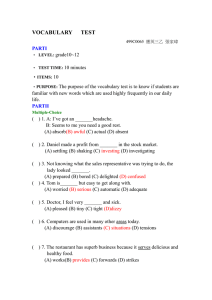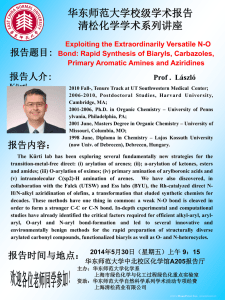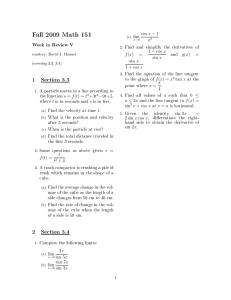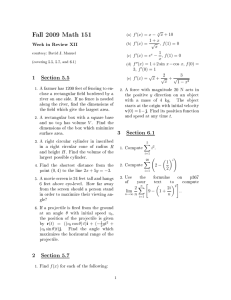¼ ½ ¼ Ґ ½ ¼ ½
advertisement
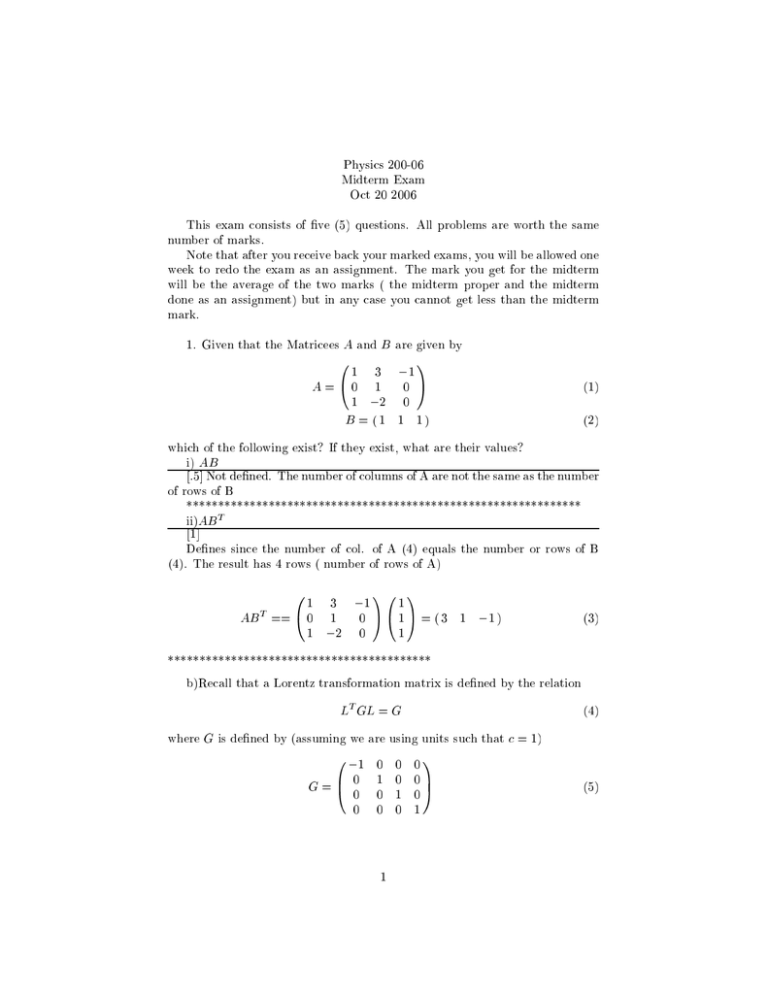
Physis 200-06
Midterm Exam
Ot 20 2006
This exam onsists of ve (5) questions. All problems are worth the same
number of marks.
Note that after you reeive bak your marked exams, you will be allowed one
week to redo the exam as an assignment. The mark you get for the midterm
will be the average of the two marks ( the midterm proper and the midterm
done as an assignment) but in any ase you annot get less than the midterm
mark.
1. Given that the Matriees A and B are given by
01
A = 0
1
3
1
1
0 A
1
2 0
B = (1 1 1)
(1)
(2)
whih of the following exist? If they exist, what are their values?
i) AB
[.5℄ Not dened. The number of olumns of A are not the same as the number
of rows of B
***************************************************************
ii)AB T
[1℄
Denes sine the number of ol. of A (4) equals the number or rows of B
(4). The result has 4 rows ( number of rows of A)
AB
T
01
== 0
1
10 1
3
1
2
1
1
0 A1A = (3 1
0
1
1)
(3)
******************************************
b)Reall that a Lorentz transformation matrix is dened by the relation
T
L GL
=G
(4)
where G is dened by (assuming we are using units suh that = 1)
0
B
G=
1
0
0
0
0
1
0
0
1
0
0
1
0
01
0C
0A
1
(5)
Show that the matrix
0 35
B 164
L = 15
5
0
4
3
4
3
0
3
5
4
5
1
0
0
01
0C
0A
1
(6)
is a Lorentz transformation. Is this a boost Transformation?
[2.5℄
L
0
=B
T
0 35
B4
G=3
0
55
33
010
1 0CB
4 0A
5
0 1
16
4 01
0 1 0 35 15
5
4
4
0C B 3 3 1 0C
=
A (7)
4
3
0A 0
5
5 0
0 0
0
0 0 1
1
0 53 1615 45 0 1 0 53 34 0 0 1
3
4
4
4
16
(LT G)L = B
03 353 145 00 CA B 1545 13 455 00 CA (8)
0
0 0 1
0 0 0 1
16 16 + 4 4
5 4 + 16 4 + 4 1 0 + 16 3 + 4 4 + 0 0 1
+ 15
15
55
33
15 3
5
15 5
55
0
1
0
0C
= G (9)
0
0
1
0A
0
0
0
1
16
15
4
3
3
5
4
5
1
0
0
0
0
1
0
0
0
0
1
0
[1℄ The matrix is not symmetri and thus it is not a boost.
(In fat I designed it so that
01
B0
L=
0
0
0
4
5
3
5
0
1
0 010 5 4
0 0
3
3
3
5 0C
34 53 0 0 A
A
4
0
5
0 0 0 1
0 1
(10)
Whih is a rotation ( the rst row and olumn are all 0 exept the very rst
term), times a boost (it is symmetri)
****************************************************
2) Explain the signiane of the series of experiments whih led Einstein
to postulate Speial Relativity. What where the postulates about the world he
used in deriving Speial Relativity?
The three ruial experiments were a) Bradley's aberation experiment whih
showed that the earth moved, b) Fizzeau experiment whih showe that if there
is an aether drag it is weird and the amount of drag depends on the index of
refration of the light, ) Mihaelson Morley whih showed that the aether drag
must be omplete sine no eet of the earth's motion ould be seen.
[ 1 mark eah, but for full marks perhaps a bit of elaboration on at least one
of them.℄
The two postulates i) No experiment an tell the state of motion of any
observer who is not ated upon by a fore.
2
ii) The apeed of light in one frame is the same value independent of diretion or other attribute, and thus by the above must be in all frames.
[2℄ *******************************
3) Derive the length ontration{ Ie a moving meterstik appears to be
shorter than the same meter stik at rest. How fast would the meter stik have
to travel so that a meter stik looked like a yard stik? ( a metre is almost
exatly 13
12 of a yard.)
Many ways of doing this. Easiest is to say in the~ frame, the rod is at rest
with one end at x~lef t = 0 and the other at x~right = L . We an write this in
terms of the oordinates in the other frame, as
x
~lef t
=
q
1
x
~right
=
q
1
1
v2
2
v2
2
1
(xlef t
vt)
(11)
(xlef t
vt)
(12)
Subtrating these and demanding that we measure xlef t and xright at the same
time t we have
L
= x~right
x
~right
=
1
q
1
or
(xright
xlef t )
=
v2
2
r
1
(xright
v2
L
2
xlef t )
(13)
(14)
Ie the dierene
q v2between the left and right oordinates of the ends at the same
time t is 1 2 times the length of the rod at rest.
[1℄ for knowing what the length ontration is. [1℄ for knowing that the
meadurement in the frame in whih the rod is moving must be made at the
same time in that frame. [3℄ for giving a oherent derivation of the ontration.
*****************************************************
4) i) Given that the fore on a partile in the rest frame of the partile is of
the form
001
B F CA
F = 0
x
(15)
0
What is the fore in a frame moving with veloity v in the +x diretion? What
is the magnitude of the spatial omponents of the fore in this new frame?
[2℄This is a simple transformation of the vetor omponents into the new
Lorentz frame.
3
~
F
t
~
F
t
=
q
1
=
q
1
1
1
(Ft
2
v
(Fx
2
v
v
2
v
2
Fx )
Ft )
=
q
=
q
v
1
1
v2
2
v2
2
1
Fx
Fx
(16)
Thus the spatial omponent of the fore inreases when looked at in a moving
frame. (a frame in whih the veloity of the partile is non-zero)
****************************************
ii) Joe argues that obviously things an go faster than light. Imagine applying a fore to a partile to make it go at 4/5 . Now apply that same fore
again to the partile and it will again inrease its veloity by 4/5 bringing the
total to 8/5 whih is larger than . What (if anything ) is the problem with
his argument?
[3℄There are many ways that the argument is wrong and his argument is
ambiguous. If he means that in eah ase the fore IN TH FRAME of the
partile is applied, than in eah ase in the frame in whih the partile is at
rest before the appliation, the inrease in veloity will be the same. But the
hange in veloity as seen in the initial frame where the partile was at rest is
not simple the addition of veloities{ in relativity the ombination of veloities
is not simple addition, but is given by the rule
vf
=
1 + 54 54j =
4
4
5 + 5
8
40
5
41 = 41 < 25
(17)
If he means that he is going to give the same fore to the partile in his own
frame, then from part a) the fore in the rest frame
just before
q of the4 2partile
3
he gives the seond push is smaller by a fator of 1 ( 5 ) = 5 , and thus the
inrease in veloity will be even less than it was in the rst assumption, and the
40
ombined veloity will be even less than the about 41
****************************************************************8
5) A partile with veloity 54 and rest mass energy of 1MeV deays into
two gamma rays, with one of the gamma rays travelling in the same diretion
as the original partile was travelling. What is the total energy of the original
partile? What is the nal energy of that gamma ray whih travels in the same
diretion as the original partile did? (Note that a gamma ray is a massless
partile ).
Let us assume that the original partile is travelling in the diretion x.
Then
011
0 E 1 0 1 1
p
M
=B
C = E B C = q M B CA
0
0 A 0A
p
0
v
1
0
4
v2
2
v
0
(18)
is the momentum before hand, with M 2 = 1M eV .
[1℄The total initial energy is
E
=
qM 2
=
v2
2
1
q1M eV4 2 = 35 M eV
(19)
(5)
1
Afterwards we have two photons, with energy and 0 and energy momentum
vetors
0 1
p
=B
0 CA
0 01
B CC
p
=B
A
(20)
0
0
0
(21)
0
0
The neatest way of solving for the energy of the gamma ray is to isolate the
other gamma ray's momentum and square both sides
0 P0
P
= (PM
P =
M 2 2
P )
(PM
P )
(22)
or
0=0
M 2 2
2PM
2(
E
+
E
v
= M 2 2 +
E
(1
v
) (23)
or
=
M 2 4
2E (1
v
)
=
3 2 3
M = M eV
2
2
(24)
Alternatively,
+ 0 = E
v
0 = E
(25)
or
=
15
4
3
M eV (1 + ) = M eV:
23
5
2
(26)
[1℄ for onservation of energy and momentum, [1.5℄ for getting the right the
form the vetors for the three partiles, [1.5℄ for the solution.
******************************************************8
5
